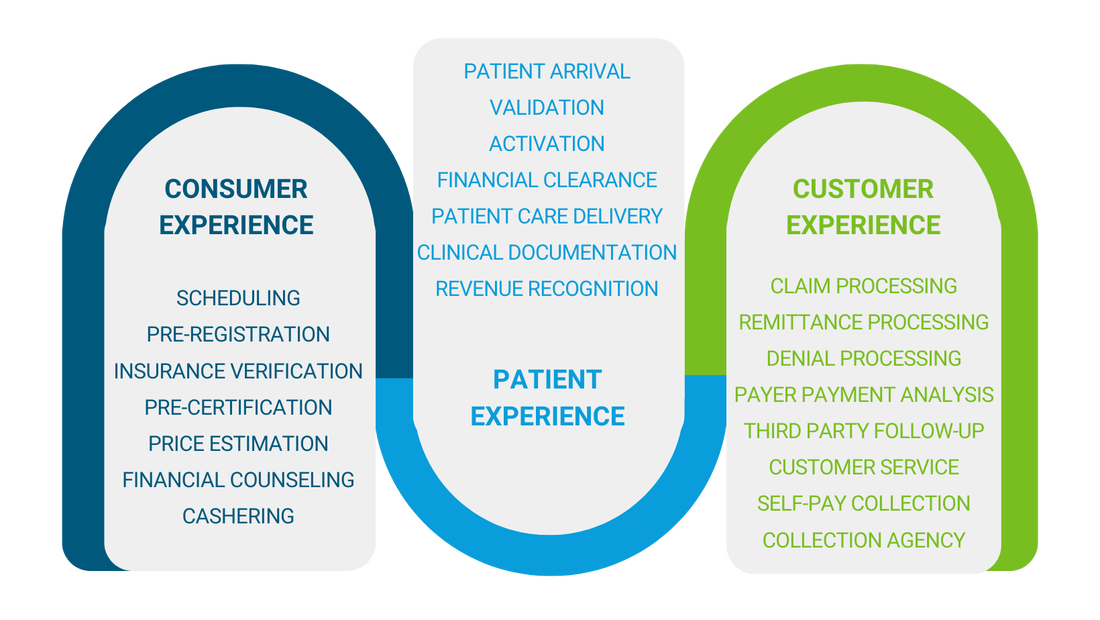The revenue cycle covers all processes from the moment a patient's information is captured to the final bill and payment being received. "Oftentimes, we see revenue cycle treated as a department that sits on the back end with billing," said Melissa Scott, director of advisory services at the healthcare technology company Change Healthcare.
"The problem with this is that everything should be done accurately and efficiently prior to claim generation to get the claim out the door and paid on the first submission. Errors in front-end processes such as registration, patient demographics, insurance verification, and eligibility can cause all the things done right after that point to be thwarted and result in a denial. Every person that touches data that ends up on a claim, or aids in the care and documentation process that support billing and reimbursement, needs to understand they are part of revenue cycle and how they impact the organization's KPIs," said Scott. The Journal of AHIMA calls attention to the impact remote work has had on managing the revenue cycle. As a result of recent widespread adaptation of remote work, RCM managers have to rely on data and dashboards to monitor productivity. They can no longer walk the floor, chat with team members, and keep tabs on the work everyone is doing. What are Key Performance Indicators (KPIs)?
Key performance indicators (KPIs) are critical indicators of progress toward an intended result. They provide an evidence-based focus for operational and strategic improvements. (KPIs will showcase the success and efficiency or call attention to areas of concern.
Having and monitoring KPIs is a great way to keep up with your RCM. KPIs will showcase the success and efficiency or call attention to areas of concern. Reviewing revenue cycle KPIs frequently will help determine if your revenue cycle has the opportunity for improvement and if it's time to invest in education for your team or seek revenue cycle management services. Where to Utilize Healthcare Revenue Cycle KPIsCode and Charge Accuracy
Medical coding is a vital part of healthcare, ensuring that patients’ conditions are accurately reflected in the medical code and that the care they received was properly documented. Coding accuracy considers any extra information that may be captured beyond DRG codes, such as the physician and date of service information, also known as the superbill. The superbill is an important document detailing patient care that goes to billing later in the process.
Medical compliance efforts look at every aspect of how charges are made to ensure accuracy and prevent any fraudulent activity. Some of the most important KPIs to track in order to monitor this closely include:
Code and Charge Productivity
To ensure that revenue is accurately recorded and paid, coding and charging managers must keep an eye out for coding and billing errors. Additionally, they must make sure claims are filed as soon as possible to avoid long delays in payment or billing. Two KPIs that revenue integrity managers should monitor for code and charge productivity include the following:
Revenue Reconciliation
Three KPIs you should gather insights on when it comes to revenue reconciliation are denial volume, avoidable write-offs, and underpayment recoveries. By understanding how these numbers are changing over time, you can identify areas where improvement is needed and make the necessary changes to ensure that revenue is not lost.
To ensure that your business is performing as expected and revenue leakage is minimal, it's important to monitor a range of metrics related to revenue integrity. These metrics can help identify areas where compliance risks are high and payment processing is low. By fixing these problems, you can improve your company's overall performance.
Revenue Cycle Management and KPI Assistance
Some of the benefits of having an optimized revenue cycle include increased cash flow, reduced cost-to-collect, greater point-of-service cash collections, and fewer denials. The revenue cycle must be efficient and effective from start to finish. Otherwise, you risk revenue leakage.
Executives faceincredible challenges when it comes to managing a revenue cycle. Sometimes, all of the variables and contributing factors affecting your revenue cycle become overwhelming. How do you know when it's time to seek assistance? Scott advises that it may be time to hire some revenue cycle assistance if underperforming KPIs include bad debt, charity, cash-to-net revenue, credit balance AR, billing turnaround and the percentage of claims paid on the first pass. Relias offers arobust library of quality online courses that allow you to invest in your staff's coding education, which can in turn impact your overall revenue cycle. If you've determined you need additional assistance, RCCS offers expert revenue cycle assessment and optimization. Comments are closed.
|
Categories
All
Archives
July 2024
|
|
DO YOU HAVE A QUESTION?
WE HAVE AN ANSWER. Office: 512.583.2000
Fax: 512.583.2002 |
FOLLOW THE LATEST INDUSTRY TRENDS
|
CELEBRATING 25 YEARS
|
@2024 Revenue Cycle Coding Strategies. All rights reserved.



